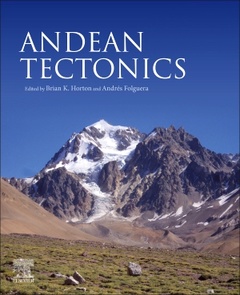Description
Andean Tectonics
Coordinators: Horton Brian K., Folguera Andrés
Language: English
Subject for Andean Tectonics:
743 p. · 19x23.3 cm · Paperback
Description
/li>Contents
/li>Readership
/li>Biography
/li>Comment
/li>
Andean Tectonics addresses the geologic evolution of the Andes Mountains, the prime global example of subduction-related mountain building. The Andes Mountains form one of the most extensive orogenic belts on Earth, spanning approximately an 8,000-km distance along the western edge of South America, from ~10°N to ~55°S. The tectonic history of the Andes involves a rich record of diverse geological processes, including crustal deformation, magmatism, sedimentary basin evolution, and climatic interactions. This book addresses the range of Andean tectonic processes and their temporal and spatial variations. An improved understanding of these processes is fundamental not only to the Andes but also to other major orogenic systems associated with subduction of the oceanic lithosphere.
Andean Tectonics is a critical resource for researchers interested in the causes and consequences of Andean-type orogenesis and the long-term evolution of fold-thrust belts, magmatic arcs, and forearc and foreland basins.
Overview
1. Seismic structure along the South American subduction zone using satellite gravity data
2. Control of subduction erosion and sediment accretion processes on the trench curvature of the central Chilean margin
3. Measuring dynamic topography in South America
Northern Andes
4. Cenozoic tectonic evolution of the North Andes with constraints from volcanic ages, seismic reflection, and satellite geodesy
5. Thermochronological constraints on Cenozoic exhumation along the southern Caribbean: The Santa Marta range, northern Colombia
6. Discriminating mechanisms for coarse clastic progradation in the Colombian foreland basin using detrital zircon double-dating
7. Latest Triassic to Early Cretaceous tectonics of the Northern Andes: Geochronology, geochemistry, isotopic tracing and thermochronology
8. Late Cretaceous to Miocene stratigraphy and provenance of the coastal forearc and Western Cordillera of Ecuador: Evidence for accretion of a single oceanic plateau fragment
9. Provenance and geochronological insights into Late Cretaceous-Cenozoic foreland basin development in the Subandean Zone and Oriente Basin of Ecuador
10. Sediment provenance variations during contrasting Mesozoic-early Cenozoic tectonic regimes of the northern Peruvian Andes and Santiago-Marañón foreland basin
Central Andes
11. Western thrusting and uplift in northern Central Andes (western Peruvian margin)
12. Structural controls along the Peruvian Subandes
13. Provenance and recycling of detrital zircons from Cenozoic Altiplano strata and the crustal evolution of western South America from combined U-Pb and Lu-Hf isotopic analysis
14. Structure and tectonic evolution of the Interandean and Subandean fold and thrust belts of Bolivia
15. Structural and thermochronologic constraints on kinematics and timing of inversion of the Salta Rift in the Tonco-Amblayo sector of the Andean retroarc fold-thrust belt, northwestern Argentina
16. Tectonic evolution of the western "Pampean" flat segment (28º-30ºS)
17. Thermal and lithospheric structure of the Chilean-Pampean flat-slab from gravity and magnetic data
18. Fragments of the late Paleozoic accretionary complex in central and northern Chile: Similarities and differences as a key to decipher the complexity of the late Paleozoic to Triassic early Andean events
19. 40Ar/39Ar constraints on the tectonic evolution of the Late Paleozoic and Early Mesozoic accretionary complex of coastal Central Chile
Southern Andes
20. Crustal structure in the southern Andes, adjacent foreland and Atlantic passive margin delineated by satellite gravimetric models
21. Cenozoic arc-related magmatism in the Southern Central and North Patagonian Andes
22. Tectonic controls on the building of the North Patagonian fold-thrust belt (~ 43°S)
23. Along-strike segmentation of the Farallon-Phoenix mid-ocean ridge: Insights from the Paleogene tectonic evolution of the Patagonian Andes between 45° and 46°30’S
24. Structure and tectonic evolution of the South Patagonian fold and thrust belt: coupling between subduction dynamics, climate and tectonic deformation
Primary: geologists, geochemists, geophysicists, exploration geologists
Secondary: hydrocarbon and mining industries
Andrés Folguera has studied different aspects of the magmatism from the Cretaceous to the Cenozoic and its sublithospheric controls through time.
- Evaluates the history of Andean mountain building over the past 300 million years
- Integrates recent studies and new perspectives on the complementary records of deformation, magmatism, and sedimentary basin evolution and their interactions in time and space
- Provides insight into the development of the northern, central, and southern Andes, which have typically been considered in isolation




